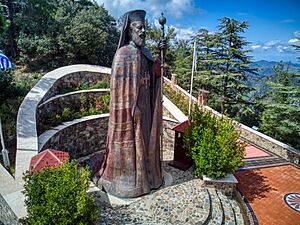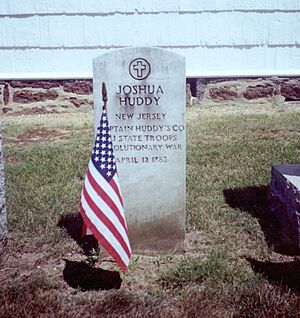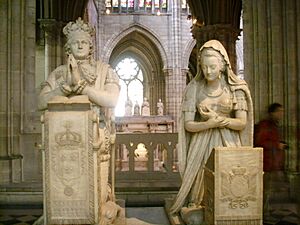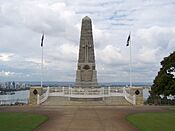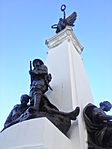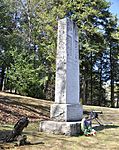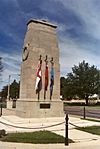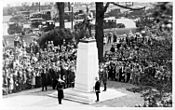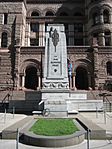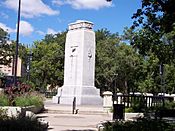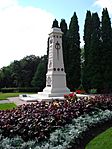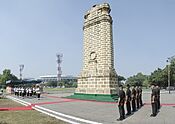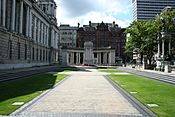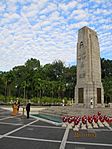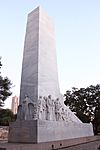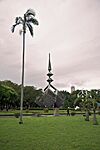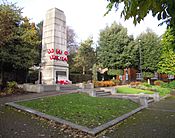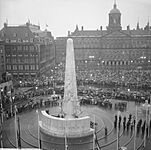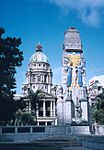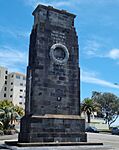Cenotaph facts for kids
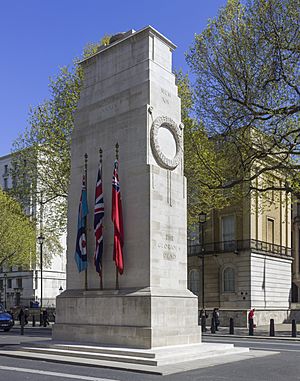
A cenotaph is like a special monument or an empty tomb built to honor someone, or a group of people, whose bodies are buried somewhere else. It can also be the first tomb for a person who was later moved and buried somewhere else. Most cenotaphs honor individuals, but many important ones remember groups of people. For example, they might honor soldiers who died for their country.
Contents
What Does "Cenotaph" Mean?
The word "cenotaph" means "empty tomb." It comes from two ancient Greek words:
- kenos, which means "empty"
- taphos, which means "tomb"
A Look Back: History of Cenotaphs
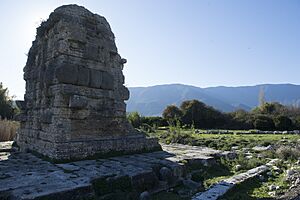
Cenotaphs were very common in ancient times. People built many of them in Ancient Egypt, Ancient Greece, and even in Northern Europe. Some of the oldest ones looked like Neolithic burial mounds called barrows.
A very famous cenotaph is in Whitehall, London. Sir Edwin Lutyens designed it in 1919. This design inspired many other war memorials in Britain and other Commonwealth countries. It was made to be a monument that was not tied to any specific religion.
Many important buildings also have cenotaphs inside them. For example, the Church of Santa Engrácia in Lisbon, Portugal, which became a National Pantheon, has six cenotaphs. These honor famous Portuguese figures like Vasco da Gama, a famous explorer. In Italy, the Basilica di Santa Croce in Florence has a cenotaph for Dante Alighieri, even though he is buried in a different city.
Cenotaphs Around the World
Africa
South Africa's Cenotaphs
The city of Durban has a unique and colorful cenotaph. It is made of granite and decorated with bright ceramics.
Gqeberha (formerly Port Elizabeth) also has a cenotaph. It was designed by Elizabeth Gardner to remember the soldiers who died in the First World War (1914–1918). It has statues and panels showing scenes from the war.
Zambia's War Memorials
In Livingstone, Zambia, there is a cenotaph near the Victoria Falls. It lists the names of men from Northern Rhodesia who died in the First World War. It was officially opened in 1923.
Another cenotaph is in Lusaka, Zambia's capital. It remembers Zambians who fought and died in both World War I and World War II.
The Americas
Argentina's Falklands War Memorials

In Buenos Aires, there is a monument known as the "Cenotaph" in Plaza San Martín. It honors Argentinian soldiers who died in the Falklands War in 1982. It has black marble plaques with the names of the fallen and a special flame.
There is also a copy of the Argentine Military Cemetery from the Falkland Islands at Campo de Mayo, near Buenos Aires.
Bermuda's London Replica
In Hamilton, Bermuda, there is a limestone copy of the famous Cenotaph in Whitehall, London. It was built to honor war dead.
Canada's National War Memorials
Canada has many important cenotaphs to remember its war dead. The National War Memorial in Ottawa is a cenotaph with a bronze sculpture on top. Other major cities like Montreal, Toronto, and Vancouver also have their own cenotaphs.
Falkland Islands' Liberation Memorial
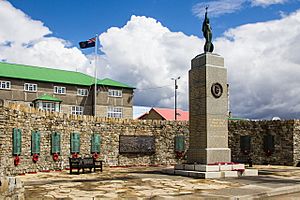
The Falkland Islands have several memorials for those who died in the 1982 Falklands War. The main one is the 1982 Liberation Memorial in Stanley. It lists all the British military units that took part in the conflict. The names of the 255 British military personnel who died are listed on plaques behind the memorial.
Special services are held here every year on June 14th (Liberation Day) and on Remembrance Sunday.
United States' Cenotaphs

In the United States, Yale University has a cenotaph honoring students who died in battle. The John Fitzgerald Kennedy Memorial in Dallas is also often called a cenotaph.
The Battle Monument in Baltimore, Maryland, remembers the Battle of Baltimore in 1814. It has an Egyptian Revival style base and is considered one of America's first war memorials.
A cenotaph for the brave defenders of the Battle of the Alamo (March 1836) stands in front of the Alamo mission chapel in San Antonio, Texas. This cenotaph is empty because the bodies of the fallen were cremated.
At Virginia Tech, a cenotaph on top of the War Memorial Chapel honors all Virginia Tech cadets who died in battle. It lists the names of those who received the Medal of Honor.
Maya Lin's Memorial Wall at the Vietnam Veterans Memorial in Washington D.C. is another famous cenotaph. It has the names of about 58,000 service members who died in the Vietnam War.
In New London, Texas, a cenotaph remembers the more than 300 students and teachers who died in the New London School explosion in 1937.
Asia
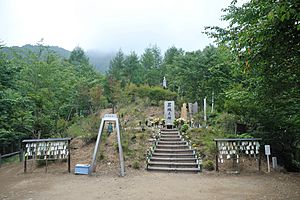
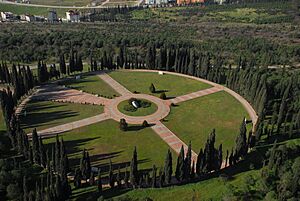
Across Asia, many cenotaphs were built after World War I. These include the Cenotaph in Hong Kong, and others in Kuala Lumpur, Singapore, and Colombo.
Other cenotaphs in Asia remember different events. The concrete Memorial Cenotaph at the Hiroshima Peace Memorial Park honors the victims of the 1945 atomic bomb attacks. The cenotaph in 228 Peace Memorial Park in Taipei, Taiwan, remembers the February 28 incident. In the Philippines, a cenotaph at the Manila North Cemetery honors 24 Scouts who died in a plane crash.
In Khejarli, India, a cenotaph remembers 363 Bishnoi people who were killed in 1730 while protecting their sacred trees.
In Kocaeli Province, Turkey, there is a large cenotaph for the ancient Carthaginian general Hannibal.
Europe
Belgium's Interallied Memorial
The Interallied Memorial of Cointe in Liège, Belgium, was built after World War I. It includes a cenotaph with a tower and a church. Many monuments from Allied nations are displayed there.
France's Famous Cenotaphs

In the Museum of Aquitaine in Bordeaux, you can find the cenotaph of Michel de Montaigne. He was a famous French writer and philosopher. This tomb was made in 1593, a year after he died.
United Kingdom's Cenotaphs
London's Cenotaph
The most famous cenotaph in the UK is in Whitehall, London. Sir Edwin Lutyens designed it. It replaced an earlier wooden version built in 1919. This monument is very simple, with just a carved wreath and the words "The Glorious Dead." It was first meant to remember those who died in the First World War, but now it honors all British service members who have died in any war. The dates of both the First and Second World Wars are carved on it. This design has been copied for many other war memorials across the British Empire. Each November, political leaders and former prime ministers gather here for Armistice Day and Remembrance Sunday to lay wreaths.
Belfast's Cenotaph
The Cenotaph in Belfast, Northern Ireland, is in the grounds of Belfast City Hall. It is about 9.5 meters (31 feet) tall and has carvings of laurel wreaths, which symbolize victory and honor. This cenotaph is where the annual Northern Ireland memorial service is held on Remembrance Sunday.
Oceania
Australia's Anzac Day Memorials
In Australia, Anzac Day ceremonies often take place at war memorials, many of which are cenotaphs. Examples include the Hobart Cenotaph, the Sydney Cenotaph, and the obelisk in Kings Park, Perth.
New Zealand's War Memorials
New Zealand also holds Anzac Day events at local war memorials. Cenotaphs there include the Dunedin Cenotaph, the Wellington Cenotaph, and the Auckland War Memorial Museum Cenotaph, which is a copy of the Whitehall Cenotaph.
Cenotaphs for the Missing
While many cenotaphs honor people buried elsewhere, some are for those whose bodies were never found. This is especially true for people lost at sea. For example, some cenotaphs remember victims of the RMS Titanic whose bodies were not recovered.
In Inishmore, one of the Aran Islands of Ireland, fishermen often died at sea. Because of this, each family used to have a memorial called leachtaí cuimhneacháin (memorial cairns) for those lost. Most were built in the 1800s.
Chhatris: Indian Cenotaphs
In India, cenotaphs are a key part of Hindu architecture. Later, Mughal rulers also used them. Many mausoleums of Mughal Emperors have two burial chambers: an upper one with a cenotaph and the real tomb below it. The term chhatri comes from a word meaning "umbrella." These canopy-like structures are found across northwestern India, especially in Rajasthan. Chhatris are often built at the cremation sites of important or wealthy people. They can be simple, with just a dome on four pillars, or much larger buildings with many domes and rooms. Sometimes, the inside of a chhatri is beautifully painted.
Cenotaphs in Art
Cenotaphs have also been featured in many famous artworks, such as:
- The Cenotaph to Reynold's Memory by John Constable (around 1833)
- Elevation for Newton's Cenotaph, Perspective by Etienne-Louis Boullée (around 1785)
- The Cenotaph of Jean Jacques Rousseau by Hubert Robert (1794)
Digital and Space Cenotaphs
In today's world, you can even find "virtual" cenotaphs in video games like World of Warcraft and The Elder Scrolls series.
They have also been created in the augmented reality game Ingress to honor people like the MIT police officer Sean Collier and victims of the 1942 Struma disaster.
On January 13, 2016, some amateur astronomers in Belgium created an asterism (a pattern of stars) near Mars. They dedicated it to David Bowie at the exact time of his death. When connected, these seven stars form the famous lightning bolt from his Aladdin Sane album cover.
Gallery
-
Remembrance Day parade at the Cenotaph in Hamilton, Bermuda.
-
State War Memorial in Kings Park, Perth, Australia.
-
Cenotaph in Port of Spain, Trinidad and Tobago.
-
Port Arthur Cenotaph in Waverley Park, Thunder Bay, Ontario.
-
Cenotaph in Victory Square, Vancouver, British Columbia.
-
Cenotaph in Victoria Park, Regina, Saskatchewan.
-
The Cenotaph in Donegall Square in Belfast.
-
Étienne-Louis Boullée's fantasy sketch Cénotaphe a Newton (1784).
-
Kuala Lumpur cenotaph at the National Monument, Kuala Lumpur, Malaysia.
-
Cenotaph at The Alamo, Spirit of Sacrifice, San Antonio, Texas.
-
Cenotaph in Aldershot in the UK, 'Home of the British Army'.
-
National Monument in Amsterdam, The Netherlands.
-
The Cenotaph in Cape Town, South Africa.
-
The Cenotaph in Durban, South Africa.
-
Cenotaph in New Plymouth, New Zealand.
See Also
 In Spanish: Cenotafio para niños
In Spanish: Cenotafio para niños


